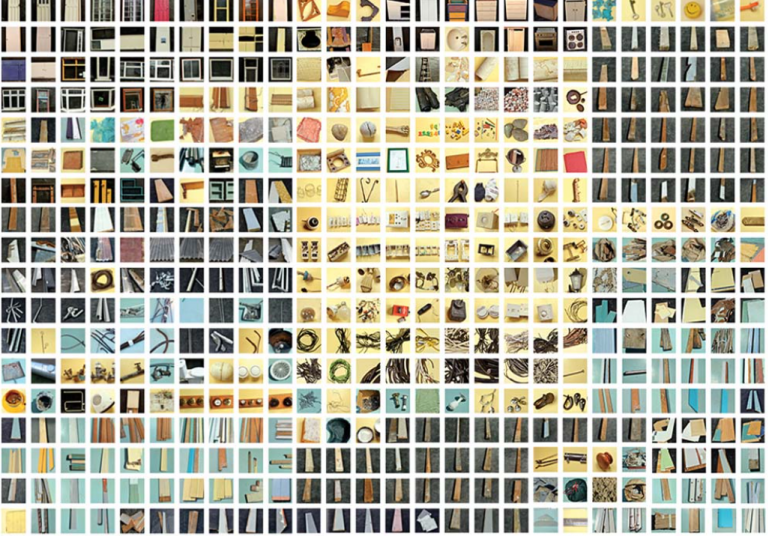



Practically, Whole House Reuse highlighted the waste generated by demolitions and encouraged creative problem solving and innovation around future uses for materials. As a social initiative, however, the project offered a salve for urgentsocial and cultural needs of a post-disaster environment. In post-earthquake Christchurch, the project was a social enterprise that removed resources from a site of trauma and offered them as an impetus for a creative process of renewal. It asked that we redefine such places and our relationship to them, proposing deactivated residential space as not defined by destruction, but instead by new creation.
Whole House Reuseoffersa creative and therapeutic outlet –a second life for materials andthe opportunity to create something meaningful and beautiful from disaster, a metaphorical spring for a devastated city and population. The flaws and the blemishes artists must work around when using recycled material became the voice of the material. Such imperfections speak of place and promote an understanding of how materials might carry a sense of place into their new form. An echo of pre-earthquake lives, homes and plots of land lives on in the art works and items created. Whole House Reuseinitiates a conversation between material, maker and owner of the new item.
Creative practitioners have turneddemolition waste from the Whole House Reuseproject into art works, furniture, jewellery and other objects. These new pieces are not simply the form they take, but speak of their former life – the stories and social history of 19 Admirals Way, the time encapsulated by layers of paint and wallpaper and the memories created within the home. The items celebrate the countless homes, family possessions and land lost. They operate as items of history, of heritage and, most importantly, of hope and renewal.
Attached to this case study are 2 early proposed designs and an image of the ‘catalogue of resources’ the Whole House Reuse project produced.
Practically, Whole House Reuse highlighted the waste generated by demolitions and encouraged creative problem solving and innovation around future uses for materials. As a social initiative, however, the project offered a salve for urgentsocial and cultural needs of a post-disaster environment. In post-earthquake Christchurch, the project was a social enterprise that removed resources from a site of trauma and offered them as an impetus for a creative process of renewal. It asked that we redefine such places and our relationship to them, proposing deactivated residential space as not defined by destruction, but instead by new creation.
Whole House Reuseoffersa creative and therapeutic outlet –a second life for materials andthe opportunity to create something meaningful and beautiful from disaster, a metaphorical spring for a devastated city and population. The flaws and the blemishes artists must work around when using recycled material became the voice of the material. Such imperfections speak of place and promote an understanding of how materials might carry a sense of place into their new form. An echo of pre-earthquake lives, homes and plots of land lives on in the art works and items created. Whole House Reuseinitiates a conversation between material, maker and owner of the new item.
Creative practitioners have turneddemolition waste from the Whole House Reuseproject into art works, furniture, jewellery and other objects. These new pieces are not simply the form they take, but speak of their former life – the stories and social history of 19 Admirals Way, the time encapsulated by layers of paint and wallpaper and the memories created within the home. The items celebrate the countless homes, family possessions and land lost. They operate as items of history, of heritage and, most importantly, of hope and renewal.
The concept for the project arose in the months following the February 2011 earthquake in Christchurch. Initial funding was sought in early 2013, and the first stage of the project - "Deconstruction" - began in July 2013 with the deconstruction of the house, followed by the cataloguing process. Over a period of 7 days in August and September 2013 materials from the house at 19 Admirals Way were salvaged, documented and stored; filling six garages
The "Design" stage began in January 2014, along with the release of the design brief and our first publication, "Whole House Reuse: Deconstruction". There were two design rounds, with the second round ending in June 2014. This marked the beginning of the "Reuse" stage, where successful participants were allocated materials to create their works. This stage is currently still in progress, and includes several group/community workshops and projects. The final exhibition, which will be the culmination of the project, will be held at the Canterbury Museum from the 29th May-23rd August 2015.In post-earthquake Christchurch, the project was a social enterprise that removed resources from a site of trauma and offered them as an impetus for a creative process of renewal. From the Whole House Project: "Following the Christchurch earthquakes many pieces of architectural and domestic history were put before the digger. Mystified and astounded by the haste of the demolition and the degree of waste, homeowners' sense of loss is amplified. Whole House Reuse project promotes respecting and honouring the previous life and material of one particular, but typical, home due for demolition. This action offers the community a chance for re-empowerment and the opportunity for reflection, understanding and celebration of what has been lost. To emphaisis the utility of materials currently disposed of, WHT specifies only craft/art objects with purpose and use are made from this home. Many people have expressed the benefits this project brings to the community in Christchurch in terms of this careful act being a clear acknowledgement of an issue with which there had previously been very few opportunities for community engagement."
All copyright belongs to Shanghai Academy of Fine Arts, Shanghai University.


